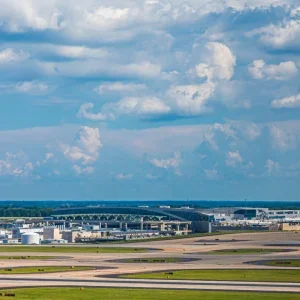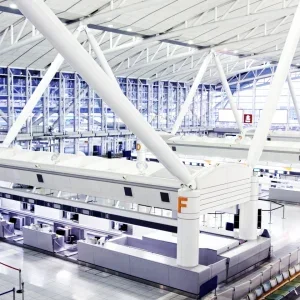Hamburg has long been a city of flying machines. In 1910, Count Ferdinand von Zeppelin gathered a crowd of curious townsfolk to regale them about a recent invention, his eponymous Zeppelin. A year later, the new Hamburg Airport was ready to go. For a time, the Hamburg-America Zeppelin line was the most glamorous way to cross the Atlantic, with passengers wined and dined to New York in just 48 hours.
It was not to last, of course. The Hindenburg disaster, in 1937, put an abrupt end to the Zeppelin age, but Hamburg was swift to adjust. Apart from a brief pause during the Second World War, the airport has successfully hosted passenger aircraft ever since. Today, Hamburg is one of the biggest airports in the region and welcomes 17 million passengers annually, flying to over 140 destinations.
But with increasing demand and tight space, Hamburg has been forced to adapt yet again, this time by installing self-bag-drop machines in one of its terminals. The process has not always been easy. Yet by working closely with airlines, and keeping abreast of passenger worries as they appear, the airport is scoring considerable successes, sharpening infrastructure and fixing the passenger experience along the way.
Bad old days
Drive to Hamburg Airport from the harbour and you will barely leave town. You instead pass by miles of drowsily handsome pre-war suburbs, almost up to the runway itself. Spaced about are car dealerships, pizza joints and community gardens, some nearly a century old. In other words, Hamburg is a quintessential urban airport, lacking the open space of a Gatwick or a Charles de Gaulle.
But with rapid growth – passenger numbers at Hamburg have jumped by nearly five million since 2010 – airport bosses were in no position to sit still. Nor could they really bulldoze the neighbours either. “We are a city airport and do not have the capacity to expand further,” says Mirjam Froehlich, head of business support in Hamburg Airport’s aviation department. “We were having to stay in the two terminals we had and still manage to get through the growing number of passengers.”
A lack of space, meanwhile, was being exacerbated by logistical stresses. As airlines reduced the time passengers had to check in for their flights, worried travellers would arrive too early, milling around and blocking check-in areas. Things could be especially grim during busy periods, remembers Froehlich, who in her early years at Hamburg worked as assistant to the CEO. If an airline had six flights leaving at once, or the summer holidays had just begun, people simply had to “stand and wait” to leave their bags.
Hamburg is hardly alone. As European passenger numbers top one billion annually, airports across the continent are feeling the strain. The results are often similar to the confusion once witnessed by Froehlich and her colleagues. Angry British tourists recently waited two hours to check in at Menorca, while regulators fined Dublin Airport €600,000 for not getting passengers through security quick enough.
Hands-off experience
Finding a way past these challenges has led many airports to new technology. Heathrow, for example, has fitted biometric software that scans passengers automatically. Other offerings are more eclectic. In Edinburgh, travellers can download Neatebox, a personalised help app for passengers with disabilities. At Munich Airport, a humanoid robot (dubbed Josie Pepper) greets travellers and doles out advice.
In its own way, Hamburg Airport has embraced sophisticated equipment too, albeit focusing on a more humdrum part of the flying experience. Unable to build a whole new terminal, managers instead installed 10 self-bag-drop kiosks, letting passengers leave their luggage without waiting on the whims of airline staff.
Since the scheme began in early 2018, the airport has doubled its stock of machines, and Froehlich is thrilled with the results. “The whole process is now definitely faster,” she says. “You can check in and don’t need to wait for the kiosk to open. You can drop your bag, go through security and do whatever you feel like until you go to your gate. It’s just more relaxing.”
Though Froehlich has no official statistics to prove her claim, similar work elsewhere certainly seems to support it. By using a self-service system – letting passengers check in early and cutting bottlenecks – Oslo Airport can process a suitcase every 10 seconds. To put that into perspective, it takes a full 90 seconds to check in a bag across a desk, dealing with a worn-out airline worker. Birmingham Airport recently issued similar results, using self-service bag drops to cut check-in queues from 20 minutes to just five. No wonder the number of airports installing self-bag-drop machines is predicted to rise to 42% by 2021, up from 18% six years earlier.
42%
Airports predicted to be installing selfbag- drop machines by 2021.
Statista
In part, these successes are down to the devices themselves. Operated by Materna, a Dortmund-based IT company, Hamburg’s Air.Go range is elegantly designed and simple to use. For example, the kiosks immediately detect oversized items, warning passengers to check them separately. Similar blocks are in place for prams and trekking bagpacks with dangling straps, both of which could jam the conveyer. Air.Go machines even photograph luggage automatically, a godsend for insurance claims if baggage handlers are having a bad day.
Nor are Materna machines just helpful for passengers. Because they are ‘common-use selfservice’ (CUSS), they can be used by several different airlines. If a certain carrier wants to charge for extra bags, for instance, it can easily integrate card payments into the system. At the same time, the machines can be converted from being two-step to one-step – letting customers print their boarding cards and check their bags at a single kiosk.
No big deal
As positive as all this seems, Froehlich is aware that a project of this scale is never easy. Early on, working with airlines and Materna could be challenging, especially when it came to finicky computer problems. “You really need the airport IT and the airline IT to work together,” she explains. “There’s a lot of communication necessary to get the airline connected to the machines. Who needs to do what to open which firewall to get the data flowing.”
€600,000
Dublin Airport was fined for not getting passengers through security quick enough.
CAR
If back room management ultimately proved to be no big deal, a broader struggle was the customers themselves. Long used to waiting their turn with an airline representative, some were bewildered by this new world of automated bag drops. Even when the machines explained how to tag their luggage, some passengers reverted to what they’d seen many times before, trying to rip off a nonexistent sticker at the back.
The way round this particular issue was to use common sense, billeting staff in the departures hall to reassure puzzled flyers. These days, many people remark how simple check-in feels, but a practical approach is key to Froehlich’s work in general, especially when so much depends on checking how passengers actually behave. “By seeing the kiosks in operation you can see what works and what doesn’t,” she says. “What is understandable for the passenger and what isn’t.”
In concrete terms, keeping an eye open has led managers to tweak everything from the size of airport signs to the security system so passengers can’t drop luggage without an ID check. Even when carriers have decided how they want their kiosks to work, meanwhile, Froehlich and her team keep at it, gathering their thoughts and encouraging the airlines to make improvements.
On the case
With its Air.Go project going so well, Hamburg Airport is keen to expand. SAS and Turkish Airlines are preparing to join the seven airlines already enrolled in the scheme, while airport bosses plan to also introduce Air.Gos to Hamburg’s second terminal. All this is typical of an industry jumping to adopt self-bag-drop technology. Materna alone now services airports everywhere from Toronto to Bengaluru; competitors like SITA are busy working in Indonesia and the Dutch Caribbean.
For her part, Froehlich is excited for this growth, but warns that the hurry towards selfservice does have limits. Smaller airlines, or ones that fly seasonally, will probably stick to traditional check-in methods. Security is another barrier. In the US, the Transport Security Administration forces officials to check that the person dropping off a bag is who they claim to be, limiting the space for automated technology.
But overall, Froehlich is certain self-bag-drop technology is here to stay, especially as CUSS machines allow multiple airlines to use the same technology. “You have to work with the infrastructure you have, and you’re forced to find ideas to occupy that infrastructure.”
It seems appropriate that Hamburg Airport learned this quicker than many. It serves a city that is used to being defiant; its citizens first pushing off in airships as the rest of the world sat and stared.




